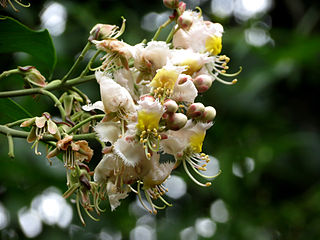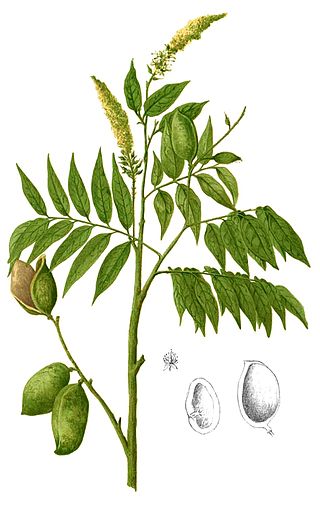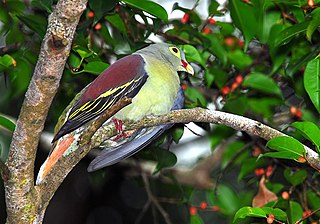
Podocarpus is a genus of conifers, the most numerous and widely distributed of the podocarp family, the Podocarpaceae. The name comes from Greek πούς + καρπός. Podocarpus species are evergreen shrubs or trees, usually from 1 to 25 m tall, known to reach 40 m (130 ft) at times. The cones have two to five fused cone scales, which form a fleshy, berry-like, brightly coloured receptacle at maturity. The fleshy cones attract birds, which then eat the cones and disperse the seeds in their droppings. About 97 to 107 species are placed in the genus depending on the circumscription of the species.

Nageia is a genus of conifers belonging to the podocarp family Podocarpaceae. Nageia includes evergreen shrubs and trees, from one to 54 meters in height. A 2009 treatment of the genus recognized five species. Some authors consider Nageia formosensis to be a separate species from Nageia nagi, thus recognizing six species. The podocarp genera have been reshuffled by various botanists. Most recently, several species formerly classed as Nageia were moved to the new genus Retrophyllum, while Nageia falcata and Nageia mannii were moved to the new genus Afrocarpus.

Calophyllum is a genus of tropical flowering plants in the family Calophyllaceae. They are mainly distributed in Asia, with some species in Africa, the Americas, Australasia, and the Pacific Islands.

Sphaeropteris is a genus of tree fern in the family Cyatheaceae. It has been treated as a subgenus within the genus Cyathea, but is accepted in the Pteridophyte Phylogeny Group classification of 2016.

Hiptage benghalensis, often simply called hiptage, is a perennial, evergreen liana native to India, Southeast Asia, Taiwan, and the Philippines. Its habitat is variable and prefers climates ranging from warm temperate to tropical. In Hawaii, where H. benghalensis is considered a weed, as it is in Australia, Mauritius and Réunion, it grows from sea level to 1,000 m (3,281 ft). H. benghalensis is cultivated for its white-pink scented flowers.

Crudia is a genus of plants in the family Fabaceae.

Erythrophleum is a genus of legume in the family Fabaceae. It includes ten species native to sub-Saharan Africa, Indochina, southern China, and northern Australia.
Podocarpus teysmannii is a species of conifer in the family Podocarpaceae. It is found in Indonesia and Malaysia.

Treron is a genus of bird in the pigeon family Columbidae. Its members are commonly called green pigeons. The genus is distributed across Asia and Africa. This genus contains 30 species, remarkable for their green coloration, hence the common name, which comes from a carotenoid pigment in their diet. Green pigeons have diets of various fruits, nuts, and/or seeds. They dwell in trees and occupy a variety of wooded habitats. Members of this genus can be further grouped into species with long tails, medium-length tails, and wedge-shaped tails. Most species of green pigeon display sexual dimorphism, where males and females can be readily distinguished by different colored plumage.

The Sumba green pigeon is a species of bird in the family Columbidae. It is endemic to Sumba Island in Indonesia. Its natural habitat is subtropical or tropical moist lowland forests. It is threatened by habitat loss.
Myristica teijsmannii is a species of plant in the family Myristicaceae. It is a tree endemic to Java in Indonesia. It is threatened by habitat loss.

Calanolide A is an experimental non-nucleoside reverse transcriptase inhibitor (NNRTI). This compound was extracted from the tree Calophyllum lanigerum, of variety austrocoriaceum, in Lundu, Malaysian state of Sarawak in 1992 by United States National Cancer Institute (NCI). Due to rarity of the raw materials and low yield of the active ingredient, total synthesis of the compound was devised in 1996. For the same reason, its sister compound (-)-Calanolide B have been touted as replacement. As a result of the discovery of Calanolide A, Sarawak Medichem pharmaceuticals company was established as a joint venture between US-based MediChem Research Inc and Craun Research Sdn Bhd, a company owned by the Sarawak state government. In 2006, Craun Research acquired Sarawak MediChem. In 2016, Craun Research announced the completion of Phase I clinical trials for Calanolide A.

Desmos is a genus of trees and shrubs in the plant family Annonaceae.

Isodon (teacost) is a genus of flowering plants in the family Lamiaceae described in 1840. It is native to tropical and subtropical parts of the Old World, primarily Asia but two species are from Africa. Many of the species are endemic to China, where it is called xiangchacai or "fragrant tea".
Archips peratratus is a species of moth of the family Tortricidae. It is found in Japan.

Rhododendron javanicum is a rhododendron species native to Indonesia, Malaysia, and the Philippines. This evergreen shrub grows to 5 m (16 ft) with bright orange flowers in spring. Plants may be terrestrial or epiphytic. Some forms from the Philippines may have red or bicoloured flowers, but are less often seen in cultivation.
Utania is a genus of flowering plants belonging to the gentian family (Gentianaceae), the tribe Potalieae, and the subtribe Potaliinae. A small genus it has 12 species.
Driessenia is a genus of flowering plants belonging to the family Melastomataceae.
Praravinia is a genus of flowering plants belonging to the family Rubiaceae.
Artocarpus teysmannii, also known as cempedak air in Malay and as tilap in Indonesia, is a species of flowering plant, a fruit tree in the fig family, that is native to Southeast Asia.












